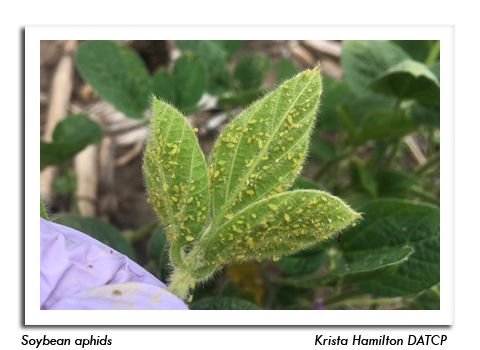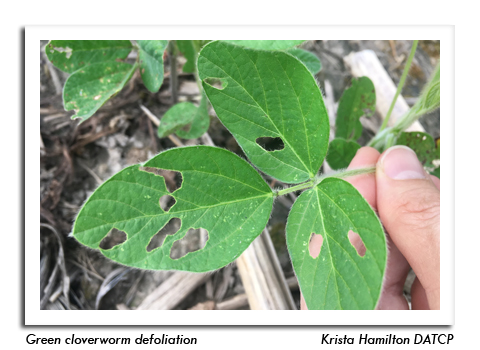
 |
|
|
Soybeans
Volume 64 Number 12 Date 07/18/2019 SOYBEAN APHID - Surveys continue to find very low densities in soybean fields. Aphids were observed in only one of the 21 soybean fields sampled from July 11-17, and just two of the 100 plants were infested with a total of 18 aphids. However, as densities increase toward the end of the month, growers and crop advisors are reminded that insecticide treatment should not be considered until the economic threshold of 250 aphids per plant on 80% of the plants has been exceeded. Aphid counts have not begun to approach this level in any soybean field surveyed by DATCP as of July 18. GREEN CLOVERWORM - Larvae are appearing in southern Wisconsin soybeans. Numbers are still low and defoliation is light (<5% fieldwide), but outbreaks of this caterpillar occur every 5-6 years and conditions are favorable for damaging populations to develop this season. JAPANESE BEETLE - Soybean fields in the west-central part of the state were showing 1-15% of plants with light leaf injury caused by a combination of Japanese beetles, bean leaf beetles, grasshoppers, green cloverworms, leafrollers, and thistle caterpillars. Japanese beetle is currently the most prevalent soybean pest. The recommended sampling method for defoliators is to select 10 plants throughout the field, choosing a trifoliate from the upper, middle and lower canopy on each plant, for a 30-leaf sample. Compare the 30 leaflets with an online defoliation estimating guide to determine the average percent defoliation, and if feeding is progressing through the canopy. Defoliation that meets the 20% threshold between the bloom and pod-fill stages and 30% in the pre-bloom soybean warrants control. Scouting several areas in the field interior, in addition to field edges where beetles are most numerous, is required for an accurate assessment. Spot treatment may be considered for border areas. Recall that soybeans can tolerate considerable defoliation without yield loss and defoliation is commonly overestimated. -- Krista Hamilton, DATCP Entomologist 




|
|
|